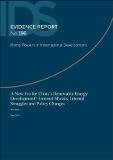| dc.contributor.author | Shen, Wei | |
| dc.coverage.spatial | China | en |
| dc.date.accessioned | 2016-06-07T14:20:08Z | |
| dc.date.available | 2016-06-07T14:20:08Z | |
| dc.date.issued | 2016-06 | |
| dc.identifier.citation | Shen, W. (2016) A New Era for China’s Renewable Energy Development? External Shocks, Internal Struggles and Policy Changes, IDS Evidence Report 196, Brighton: IDS | en |
| dc.identifier.uri | https://opendocs.ids.ac.uk/opendocs/handle/20.500.12413/11641 | |
| dc.description.abstract | As the world’s largest greenhouse gas (GHG) polluter, China’s annual emissions accounted for almost 30 per cent of the world’s total emissions in 2014 – more than the United States (15 per cent) and the European Union (10 per cent) combined (World Bank 2015). China’s efforts to curb its soaring emissions will play a decisive role in containing temperature rise and in preventing the catastrophic consequences of climate change. In recent years, the Chinese government has paid greater attention to climate change. President Xi Jinping’s attendance at the COP21 conference in Paris was a first by a Chinese leader. Before the conference, China’s climate officers submitted the country’s Intended Nationally Determined Contributions to the UN Framework Convention on Climate Change as its formal commitment to the international community to control its GHG emissions. In this document, the Chinese government pledges to peak its emissions by 2030 and promises to try to achieve this goal sooner rather than later. One of the major avenues to achieve this target is to increase the share of non-fossil fuel energy in the current coal-dominated primary energy mix to reach more than 20 per cent by 2030. The share was around 11.1 per cent in 2014 (NDRC 2015a). China’s recently released master plan for economic and social development, the 13th Five-Year Plan, also requires this share of non-fossil fuel to reach 15 per cent by 2020.
The key questions are then whether and how these targets can be met? On the surface, this does not seem an over-ambitious target. During China’s 11th and 12th Five-Year Plans between 2005 and 2015, the country transformed itself into the largest investor in renewable energy sectors in the world. However, this decade of massive wind and solar energy development only increased the share of renewable energy to less than 2 per cent of the national energy mix by 2014 – casting serious doubt on China’s future plans to decarbonise its energy system.
This Evidence Report investigates the changes in China’s wind and solar energy policies, and argues that since late 2012 a new policy paradigm has been taking shape within the Chinese renewable energy policy community due to a series of external and internal shocks. These policy changes will have a tremendous impact on how China is going to further develop its renewable energy sector. | en |
| dc.description.sponsorship | UK Department for International Development | en |
| dc.language.iso | en | en |
| dc.publisher | IDS | en |
| dc.relation.ispartofseries | IDS Evidence Report;196 | |
| dc.rights.uri | http://creativecommons.org/licenses/by/3.0/ | en |
| dc.subject | Environment | en |
| dc.title | A New Era for China’s Renewable Energy Development? External Shocks, Internal Struggles and Policy Changes | en |
| dc.type | IDS Evidence Report | en |
| dc.rights.holder | IDS | en |
| dc.identifier.ag | OT/11009/5/4/626 | |


